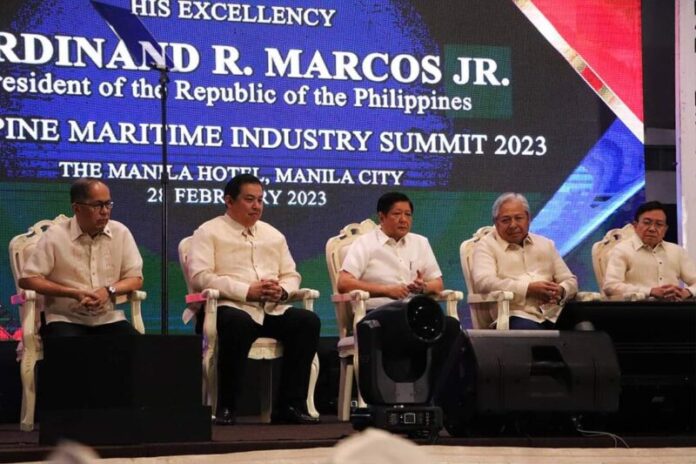
-
The Maritime Industry Authority updated its 10-year Maritime Industry Development Plan (MIDP) which aims to achieve a nationally integrated and globally competitive Philippine maritime industry by 2028
-
The MIDP goal for 2028 is for the Philippines to have a strong, and reliable Philippine merchant fleet that addresses sea transport requirements of the archipelago in support of the national development agenda
-
In the MIDP 2028, programs were categorized, some merged while other components were reduced or reclassified
-
The updated version features three overriding programs, four core programs, and one enabling program
The Maritime Industry Authority (MARINA) has updated its 10-year Maritime Industry Development Plan (MIDP) with the goal of achieving a nationally integrated and globally competitive Philippine maritime industry by 2028.
“Through this development plan—which was formulated by the MARINA and the DOTr [Department of Transportation], in coordination with relevant government agencies and key stakeholders—we will achieve our two core objectives: First, to ensure the development and expansion of the Philippine merchant fleet, and Second, to ensure the advancement of a future- ready maritime human capital,” President Ferdinand Marcos, Jr. said in a speech during the Maritime Industry Summit on February 28.
The chief executive urged concerned government agencies “to pursue a whole-of-government approach to effectively implement the MIDP 2028 as well as to continue communicating with member-states of the International Maritime Organization and the European Union-Committee on Safe Seas.”
The MIDP goal for 2028 is for the Philippines to have a strong, and reliable Philippine merchant fleet that addresses the sea transport requirements of the archipelago in support of the national development agenda.
READ: PH maritime sector seen doubling to P1.4T by 2028
The MIDP is a decade-long roadmap aimed at accelerating the development of a nationally integrated and globally competitive Philippine maritime industry. The roadmap was launched in 2017. It began implementation in mid-2019 but this was halted by the pandemic, and only updated last year.
At the start of 2023, MARINA led the final updating of the MIDP, primarily to ensure consistency with the latest Philippine Development Plan 2022-2028 and the National Transport Policy, and its alignment with the socioeconomic agenda of the new administration. Marcos earlier directed DOTr to create a maritime industry development plan that would develop and enhance the maritime sector and improve ports to allow more cruise ships to call the country, helping the tourism industry in the process.
READ: Gov’t drawing up maritime industry development plan
Under Presidential Decree No. 474 (Maritime Industry Decree of 1974), MARINA should create master plans for the industry. The last 10-year roadmap created by MARINA was in the 1980s.
In the MIDP 2028, programs were categorized, some merged while other components were reduced or reclassified. In the previous version, there were 10 priority programs that needed to be implemented until 2028.
The updated version features three overriding programs, four core programs, and one enabling program. The goals and outcomes of each program are interrelated.
The overriding programs underpin the goals and outcomes of core programs, while the enabling program is geared towards facilitating the implementation of both the overriding and core programs.
The core programs include the following:
- Modernization and expansion of the domestic shipping industry — Aims to modernize and development of a strong and dynamic domestic shipping fleet that will provide safe and efficient inter-island and trade routes, stimulate local economies, and develop new cruise routes and ports for tourism
- Promotion and expansion of the overseas shipping industry — Focuses on strengthening the Philippine ship registry and aims to expand the country’s merchant fleet, reduce reliance on foreign-flagged ships, and create employment opportunities for Filipino seafarers and shore-based maritime workers.
- Modernization, promotion, and expansion of the shipbuilding and ship repair industry — Aims to addresses the demand for modern and technologically advanced ships. Targeted as a priority outcome is the increase of domestic trading ships built in the Philippines which results in foreign exchange savings which would otherwise be paid to foreign shipbuilders.
- Promotion of highly-skilled and competitive maritime workforce—Aims to enhance the competitiveness of the maritime industry by preparing a reservoir of competent maritime human resources. This will help propagate best practices and transfer knowledge through the academe and training institutions.
The overriding programs are:
- Enhancement of maritime transport safety and security—Aims to improve safety and efficiency of Philippine ships and promote cooperation between regions.
- Promotion of environmentally sustainable maritime industry—Aims to accelerate the implementation of environmental regulations and standards to prevent pollution from shipping activities, transfer and spread of invasive aquatic species, and reduce greenhouse gas emissions from ships, thereby reducing negative impacts on the marine environment.
- Implementation of a sustainable maritime innovation, transformation, digitalization and knowledge center–Digitalization and automation in maritime transport will optimize processes, create new opportunities, and transform supply chains and trade geography.
The enabling program is the adoption and implementation of an effective and efficient maritime administration governance system. This program covers all other MIDP implementing agencies which are performing maritime transport-related functions. Vital to the success of the enabling program are components identified such as the organizational restructuring, the sustained capacity building program, the enhanced maritime multilaterals and multi-sector linkages, the enhanced systems and good governance and strategic communication and risk management.
Various stakeholder organizations pledged support to the updated MIDP during the February 28 launch, including the Associated Marine Officers’ and Seamen’s Union of the Philippines, Filipino Association for Mariners Employment, Association of Licensed Manning Agencies Maritime Group, Women in Maritime Philippines, Philippine Coastwise Shipping Association, Inter-island Deep Sea Fishing Association, Shipyard Association of the Philippines, Philippine Association of Maritime Institutions, Philippine Association of Maritime Training Centers, Inc.; Joint Manning Group, and Filipino Shipowners Association.




